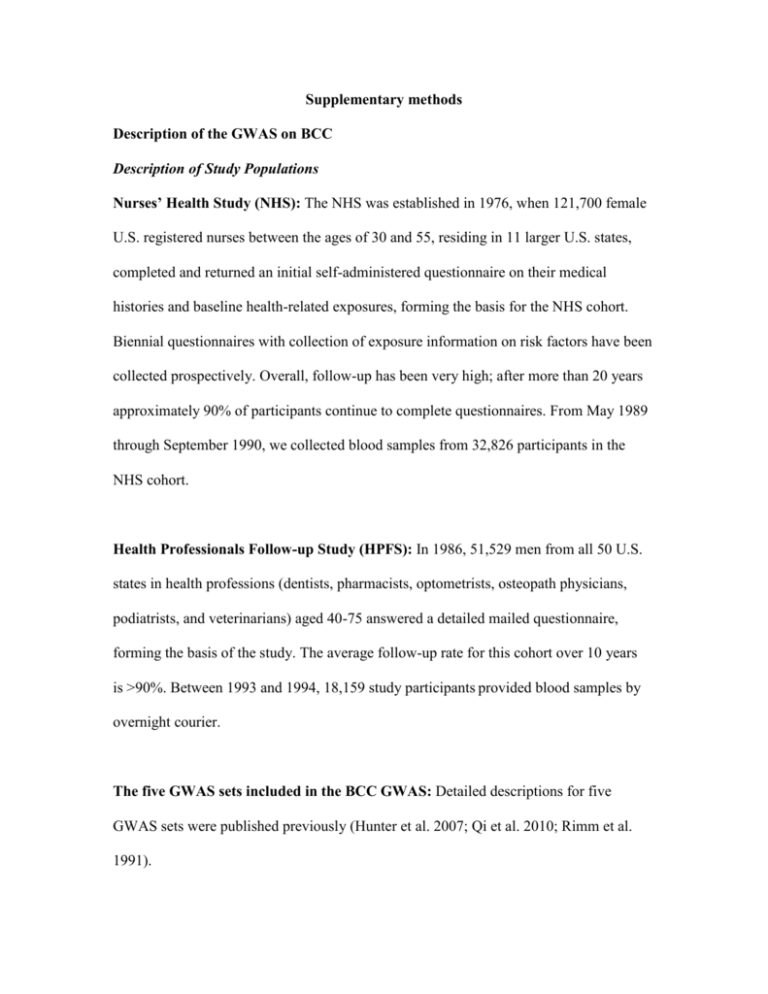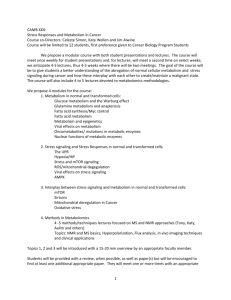Supplementary methods - Springer Static Content Server
advertisement

Supplementary methods Description of the GWAS on BCC Description of Study Populations Nurses’ Health Study (NHS): The NHS was established in 1976, when 121,700 female U.S. registered nurses between the ages of 30 and 55, residing in 11 larger U.S. states, completed and returned an initial self-administered questionnaire on their medical histories and baseline health-related exposures, forming the basis for the NHS cohort. Biennial questionnaires with collection of exposure information on risk factors have been collected prospectively. Overall, follow-up has been very high; after more than 20 years approximately 90% of participants continue to complete questionnaires. From May 1989 through September 1990, we collected blood samples from 32,826 participants in the NHS cohort. Health Professionals Follow-up Study (HPFS): In 1986, 51,529 men from all 50 U.S. states in health professions (dentists, pharmacists, optometrists, osteopath physicians, podiatrists, and veterinarians) aged 40-75 answered a detailed mailed questionnaire, forming the basis of the study. The average follow-up rate for this cohort over 10 years is >90%. Between 1993 and 1994, 18,159 study participants provided blood samples by overnight courier. The five GWAS sets included in the BCC GWAS: Detailed descriptions for five GWAS sets were published previously (Hunter et al. 2007; Qi et al. 2010; Rimm et al. 1991). 1) Postmenopausal invasive breast cancer case-control study nested within the NHS: Eligible cases in this study consisted of women with pathologically confirmed incident breast cancer from the subcohort who gave a blood specimen. Cases with a diagnosis after blood collection up to June 1, 2000 with no previously diagnosed cancer except for non-melanoma skin cancer were included. One control for each case was randomly selected among women who gave a blood sample and were free of diagnosed cancer (excluding non-melanoma skin cancer) up to and including the interval in which the case was diagnosed. Controls were matched to cases on year of birth, menopausal status, recent post-menopausal hormone (PMH) use, month of blood return, time of day of blood collection, and fasting status at blood draw (Hunter et al. 2007). All breast cancer cases were excluded from the current study. 2) Type 2 diabetes (T2D) case-control study nested within the NHS and HPFS: Diabetes cases were defined as self-reported incident diabetes confirmed by a validated supplementary questionnaire. For cases before 1998, diagnosis was made using criteria consistent with those proposed by the National Diabetes Data Group (NDDG). For cases during the 1998 and 2000 cycles, the American Diabetes Association’s diagnostic criteria were used for the diagnosis of diabetes cases. The nondiabetic control subjects were matched to cases on age, month and year of blood draw, and fasting status (Qi et al. 2010). 3) Coronary heart disease (CHD) case-control study nested within the NHS and HPFS: In both the NHS and HPFS, participants who had reported an incident CHD event on the follow-up questionnaire were contacted for confirmation and permission to review medical records was requested. Medical records for deceased participants were also sought for deaths that were identified by families and postal officials and through the National Death Index. Physicians blinded to the participant’s questionnaire reports reviewed all medical records. Fatal CHD cases were identified primarily through review of medical records, as previously described (Rimm et al. 1991). Among participants who provided blood samples and who were without cardiovascular disease or cancer at blood draw, incident CHD cases occurring after blood draw were selected as cases. Controls were selected, in a 2:1 ratio matched to cases on age, smoking, and month of blood return. References: Hunter DJ, Kraft P, Jacobs KB, Cox DG, Yeager M, Hankinson SE, Wacholder S, Wang Z, Welch R, Hutchinson A, Wang J, Yu K, Chatterjee N, Orr N, Willett WC, Colditz GA, Ziegler RG, Berg CD, Buys SS, McCarty CA, Feigelson HS, Calle EE, Thun MJ, Hayes RB, Tucker M, Gerhard DS, Fraumeni JF, Jr., Hoover RN, Thomas G, Chanock SJ (2007) A genome-wide association study identifies alleles in FGFR2 associated with risk of sporadic postmenopausal breast cancer. Nat Genet 39: 870-4 Qi L, Cornelis MC, Kraft P, Stanya KJ, Linda Kao WH, Pankow JS, Dupuis J, Florez JC, Fox CS, Pare G, Sun Q, Girman CJ, Laurie CC, Mirel DB, Manolio TA, Chasman DI, Boerwinkle E, Ridker PM, Hunter DJ, Meigs JB, Lee CH, Hu FB, van Dam RM (2010) Genetic variants at 2q24 are associated with susceptibility to type 2 diabetes. Hum Mol Genet 19: 2706-15 Rimm EB, Giovannucci EL, Willett WC, Colditz GA, Ascherio A, Rosner B, Stampfer MJ (1991) Prospective study of alcohol consumption and risk of coronary disease in men. Lancet 338: 464-8 Table S1. Association results for all the 99 tested KEGG pathways. Pathway Gene enriched1 Pathway Enrichment pvalue Autoimmune thyroid disease 25 <0.001 Allograft rejection 24 0.019 Antigen processing and presentation 47 0.028 Chronic myeloid leukemia 40 0.082 B cell receptor signaling pathway 31 0.052 Type I diabetes mellitus 29 0.054 Systemic lupus erythematosus 34 0.06 Leukocyte transendothelial migration 55 0.032 JAK-STAT signaling pathway Cell adhesion molecules (CAMs) 60 63 0.02 0.068 Graft-versus-host disease 27 0.073 Focal adhesion Glycerophospholipid metabolism 74 29 0.009 0.058 Cell Communication 28 0.12 Toll-like receptor signaling pathway 48 0.07 Phosphatidylinositol signaling system 44 0.068 Regulation of actin cytoskeleton 91 0.029 Glycerolipid metabolism VEGF signaling pathway 23 33 0.081 0.21 Neurodegenerative Diseases Natural killer cell mediated cytotoxicity 25 58 0.046 0.098 Melanoma 25 0.097 Inositol phosphate metabolism 28 0.299 Sphingolipid metabolism 21 0.153 Renal cell carcinoma 30 0.206 Fc epsilon RI signaling pathway mTOR signaling pathway 35 25 0.115 0.321 Pancreatic cancer Oxidative phosphorylation 35 73 0.265 0.343 FDR 2 0.24 2 0.59 9 0.51 2 0.42 7 0.46 5 0.59 3 0.57 3 0.52 6 0.48 8 0.51 0.49 1 0.50 2 0.56 0.53 6 0.57 7 0.54 6 0.52 3 0.49 8 0.55 0.61 7 0.62 0.59 4 0.59 2 0.65 1 0.79 9 0.77 8 0.75 0.76 9 0.74 Epithelial cell signaling in Helicobacter pylori infection 38 0.161 PPAR signaling pathway 26 0.427 Tyrosine metabolism 22 0.334 Ubiquitin mediated proteolysis 77 0.259 Fatty acid metabolism 32 0.397 Ribosome 42 0.245 Purine metabolism 82 0.292 GnRH signaling pathway 41 0.277 Acute myeloid leukemia 29 0.507 Hematopoietic cell lineage 36 0.363 Porphyrin and chlorophyll metabolism 20 0.459 Starch and sucrose metabolism 37 0.387 Glioma 30 0.353 Glycan structures - biosynthesis 2 46 0.41 Adherens junction 35 0.391 Aminoacyl-tRNA biosynthesis 31 0.543 Homologous recombination 21 0.648 Pathogenic Escherichia coli infection 26 0.611 EPEC 26 0.611 Non-small cell lung cancer 29 0.642 Melanogenesis 45 0.672 Pyrimidine metabolism Tryptophan metabolism 65 34 0.474 0.622 Tight junction SNARE interactions in vesicular transport 65 28 0.501 0.274 T cell receptor signaling pathway 39 0.373 Drug metabolism - cytochrome P450 24 0.61 Long-term potentiation 32 0.625 6 0.81 8 0.84 2 0.82 7 0.84 9 0.84 2 0.86 1 0.90 2 0.90 3 0.88 6 0.90 6 0.92 2 0.91 9 0.91 5 0.89 6 0.90 2 0.90 8 0.94 6 0.92 1 0.92 1 0.94 1 0.93 3 0.92 3 0.93 0.91 3 0.91 0.90 1 0.89 3 0.90 7 Metabolism of xenobiotics by cytochrome P450 24 0.654 Cytokine-cytokine receptor interaction 93 0.308 Valine, leucine and isoleucine degradation Vibrio cholerae infection 33 33 0.581 0.728 Endometrial cancer 28 0.805 Gap junction 39 0.724 Apoptosis 42 0.415 Small cell lung cancer 36 0.452 Fructose and mannose metabolism 24 0.499 Glutathione metabolism 31 0.777 Adipocytokine signaling pathway 32 0.651 TGF-beta signaling pathway 42 0.696 Neuroactive ligand-receptor interaction 56 0.706 DNA replication 23 0.697 Lysine degradation 27 0.562 Folate biosynthesis 22 0.557 Cell cycle 68 0.786 Bladder cancer Complement and coagulation cascades 22 24 0.742 0.817 Arachidonic acid metabolism 20 0.804 p53 signaling pathway 39 0.794 ErbB signaling pathway 37 0.579 Axon guidance 49 0.819 Insulin signaling pathway 65 0.797 Glycolysis / Gluconeogenesis 29 0.839 Propanoate metabolism 26 0.869 Colorectal cancer 43 0.887 MAPK signaling pathway Base excision repair 109 22 0.78 0.699 0.90 2 0.89 6 0.88 6 0.92 0.93 4 0.92 1 0.91 6 0.96 6 0.95 7 0.94 5 0.95 7 0.97 5 0.96 2 0.95 2 0.96 6 0.96 8 0.96 1 0.97 4 0.97 0.96 6 0.95 4 0.94 4 0.93 2 0.92 6 0.94 5 0.93 4 0.92 5 0.92 2 0.92 Calcium signaling pathway 60 0.856 Prostate cancer 49 0.887 ECM-receptor interaction 23 0.834 Long-term depression 33 0.84 Butanoate metabolism 27 0.715 Thyroid cancer 21 0.687 Glycan structures - biosynthesis 1 65 0.7 Nucleotide excision repair 33 0.724 Selenoamino acid metabolism 22 0.711 Glycine, serine and threonine metabolism 25 0.925 Pyruvate metabolism 22 0.806 Wnt signaling pathway 67 0.861 N-Glycan biosynthesis 23 0.875 1 2 The number of the genes with eSNPs, which are used for the enrichment in the pathways; Based on 1000 permutations and 99 pathways tested in total.3 Based on 1000 permutations and 99 tested pathway 0.91 3 0.92 7 0.93 3 0.92 7 0.91 8 0.91 2 0.90 4 0.90 3 0.90 1 0.91 6 0.91 3 0.96 1 0.96 6 Table S2. The representative eSNP information for the two pathways with significant enrichement in the BCC GWAS. Pathway Autoimmune thyroid disease JAK-STAT signaling pathway Genes with eSNP HLA-B HLA-G HLA-DQB1 HLA-DRB33 HLA-DRB1 HLA-DOB IFNA14 HLA-DPA1 HLA-DRB4 HLA-C HLA-A HLA-DMA HLA-DPB1 HLA-DOA HLA-E CD80 CD86 HLA-F HLA-DRA CD40 HLA-DMB CTLA4 IL21R STAM2 IFNA14 IL15RA CSF2RB IL6ST PIK3CB EP300 CBLB IFNGR2 IL2RB IL3RA STAT4 IL6R SOCS1 SOS1 CRLF2 AKT3 STAT1 EPOR STAT6 STAT5A CCND1 IL11RA IL28RA eSNP1 rs3093562 rs805262 rs2736171 rs2856683 rs7536479 rs10947342 rs9299397 rs13215763 rs7775228 rs2854050 rs9461216 rs2857211 rs3130171 rs6920606 rs13209817 rs4330287 rs7627354 rs1265156 rs8052975 rs13037326 rs12928665 rs13100355 rs4787976 rs10930939 rs9299397 rs8177600 rs2284027 rs17730330 rs6439828 rs4821998 rs9821956 rs2834212 rs2281094 rs9311913 rs4853551 rs4845617 rs3862469 rs12473092 rs2431744 rs10927041 rs6689496 rs9392697 rs10506348 rs789056 rs11228554 rs2381163 rs10903038 eSNP PBCC2 1.21E-04 5.15E-04 7.53E-04 8.19E-04 1.92E-03 1.92E-03 4.09E-03 4.11E-03 4.72E-03 5.10E-03 5.38E-03 5.54E-03 6.26E-03 7.29E-03 1.01E-02 1.16E-02 1.59E-02 4.59E-02 1.49E-01 1.59E-01 3.26E-01 7.95E-01 2.93E-03 2.96E-03 4.09E-03 7.43E-03 9.25E-03 9.47E-03 9.68E-03 1.03E-02 1.18E-02 1.32E-02 1.89E-02 2.59E-02 2.63E-02 2.69E-02 2.71E-02 2.84E-02 3.23E-02 3.24E-02 3.48E-02 3.84E-02 3.85E-02 4.05E-02 4.11E-02 4.33E-02 4.73E-02 CSF2RA IL9R IL12RB1 JAK2 IL10RB IL19 PIAS4 SPRY3 IL15 GRB2 IFNAR2 CNTFR CCND2 LEPR IL2RA ISGF3G PRLR SPRED2 CLCF1 PIK3R3 STAT5B STAT2 IL12A IFNAR1 IL12RB2 CCND3 IFNGR1 CBL SPRY2 STAM OSMR PTPN11 IL2RG TYK2 IL13RA1 1 2 3 rs3762474 rs10912203 rs426132 rs10974985 rs2243511 rs6673928 rs10402864 rs4943241 rs973431 rs9914731 rs2834153 rs1448370 rs4765769 rs3790436 rs11597536 rs1943321 rs7728551 rs840963 rs4370716 rs222616 rs4890112 rs17118403 rs2243140 rs2243600 rs3828069 rs4623235 rs10457655 rs1918 rs558366 rs12770533 rs16869234 rs7335152 rs12859844 rs409782 rs11215633 7.96E-02 8.01E-02 8.57E-02 9.21E-02 9.88E-02 1.01E-01 1.07E-01 1.15E-01 1.24E-01 1.32E-01 1.35E-01 1.47E-01 1.57E-01 1.92E-01 2.36E-01 2.98E-01 3.05E-01 3.12E-01 3.18E-01 3.42E-01 3.74E-01 4.19E-01 4.68E-01 5.07E-01 5.51E-01 5.68E-01 6.97E-01 7.89E-01 7.94E-01 8.28E-01 8.50E-01 9.06E-01 9.18E-01 9.38E-01 9.91E-01 Denotes genes with the smallest PBCC; PBCC represents p values of eSNPs for BCC association; The four genes HLA-DRB3, HLA-DRB5, HLA-DQA1, and HLA-DQA2 have the same representative eSNP: rs2856683.







![Major Change to a Course or Pathway [DOCX 31.06KB]](http://s3.studylib.net/store/data/006879957_1-7d46b1f6b93d0bf5c854352080131369-300x300.png)